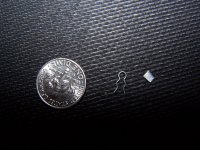So tell me please, how do I measure the resistance wire to see if it has been bypassed or not?
I get 12.96 volts when the wire disconnected from the coil & 12.77 volts when the wire is connected to the coil. I have a petronix II.
Thanks, Dave
Dave, ok first, since you have a Pertronix II, from what I understand you can safely turn the key to "run" and leave it there without damaging the Pertronix II - it is only the Pertronix I that has the issue of damage when left in the "run" position for too long without the engine running. But note that this info is just *based on my understanding*.
OK, so to determine whether you have a resistance in the wire or not I can think of three possible ways:
(1) Find the wire running from the ignition to the coil. Disconnect it from the coil. Then, with a multimeter set to measure resistance, measure the resistance on that wire from the ignition switch to the end you disconnected from the coil. If memory serves it should be 1.5ohms for the original stock "pink" resistor wire. 0 ohms means that the original resistor wire has been replaced or bypassed.
(2) Take the car out of gear and chock the wheels (see Rob's "diaper" experience :wink

. Leave the wire from the ignition switch (the one you are testing) connected to the coil. Disconnect the coil from the distributor (you don't want to get a spark to the engine when doing this experiment). Turn the ignition switch to "run" (now you have a connection from the battery to the coil through the ignition wire). Put the multimeter on "volts" and measure the voltage going to the coil (with the other probe of the multimeter hooked to ground on the battery). If the points (in this case, Pertronix) are open you are looking at a "open circuit" and you should read just the battery voltage. If the points are closed you will either read something near the battery voltage if there is no resistor or something much lower (~9v or so if I remember correctly) if there is a resistor in the wire.
Now you may wonder how to determine whether the points are open or closed? You can't tell visually with a Pertroinx. But you can check both conditions as follows: Put a socket wrench on the crank and turn it far enough (half a revolution should be sufficient) to make sure the points both close and open. If you do this and the voltage stays at ~12.xxx volt while turning the crank, then there is no resistor in the wire. If the voltage drops from ~12.xxx volts (points open) to ~9.xxx volts (points closed) and then goes back to ~12.xxx volts (points open) as you turn the crank, you've got a resistor wire. What you just did by turning the crank manually is to go from an open -> closed -> open circuit. When points are closed, current flows through the wire and, if there is a resistor, you get a voltage drop. Write down the lowest voltage you see doing this. The reason for disconnection of the coil from the distributor is that turning the crank this way will fire at least one spark and you don't want the engine to accidentally start - that would be the definition of a bad day... :wink:
(3) A, final, possibly much simpler way is to just do a visual inspection to see if you still have the original "pink" resistor wire or if its been removed or bypassed. There are probably some pictures of what this wire looks like on-line. It's somewhat distinct...
Here's a good video of how the ignition system works (in this video note that there is no resistor between ignition switch and coil) and shows how the points open and close...
https://www.youtube.com/watch?v=W94iksaQwUo
Someone please comment if they know of a simpler method or see any issue with these...


